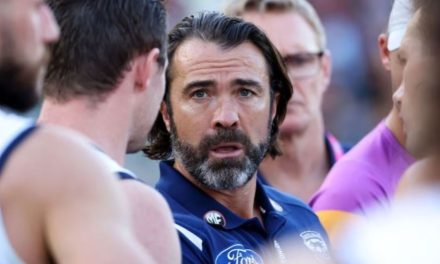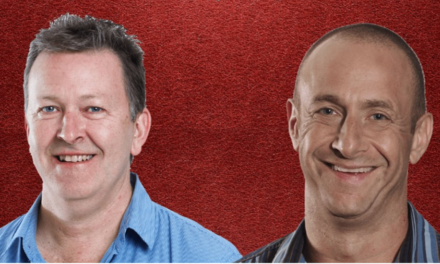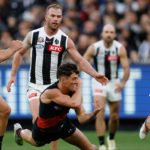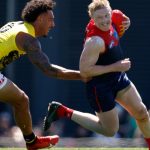Melbourne coach Simon Goodwin and captain Max Gawn hold the 2021 AFL premiership cup aloft. Can they do it again? Photo: AFL MEDIA
Nothing fuels media lust for AFL content like a good off-field controversy. Particularly when it’s the off-season and there’s nothing else to write about.
Which made the Melbourne Football Club manna from heaven these past few months, even well after the Demons had been eliminated from a second consecutive finals campaign in straight sets.
Recently there’s been at least three compelling narratives from which to choose – former club president Glen Bartlett’s on-going stoush with his former board colleagues, Clayton Oliver’s mental health struggles, and Joel Smith’s alleged drug use and pending lengthy suspension.
The overarching word in play in all those discussions, obviously, is culture. But in desperation to see cause and effect triumph, and the sometimes inexplicable make convenient sense, I reckon there’s been way too many people attempting to make two plus two equal four and coming up with 578 instead.
I refuse to do it. I will concede that the sudden retirement of Angus Brayshaw obviously hurts Melbourne in an on-field sense. But I still think the Demons have, pound for pound, the most talented list in the AFL. And I’m tipping them to win the 2024 premiership, untroubled by the white noise going on in the background.
Look, I’m not pretending any of those scenarios weren’t unhelpful in their own way. But the knee-jerk response in assuming the consequences will prove a slump in actual on-field performance from the Demons is at best naïve.
Think it through for a few moments. When the Bartlett v rest of board stoush was at its height in 2021, what were the Demons doing on the field? Umm, winning a premiership, if I recall.
Of course Oliver’s personal struggles are concerning. But they were at their height last year. In March 2024, the four-time best and fairest winner is back on deck, getting valuable miles in his legs, and ready to play another super-consistent season.
Smith? Well, with all due respect, we’re not talking about Oliver or Christian Petracca here. And even if we were, one man’s flirtations with illegal substances and even the isolated dabbling of a teammate or two doesn’t constitute, as one newspaper headline couched it dramatically, a “Cocaine Crisis”.
As former Sydney Swan Brandon Jack wrote last week: “AFLM players take cocaine. AFLW players take cocaine. Local footy players take cocaine. As do teachers, lawyers, doctors. According to federal government research, more than one million Australians used cocaine in 2019.”
That doesn’t necessarily mean a whole playing list’s performance levels are about to implode.
Like Oliver, a lot of Australians sometimes battle with their mental health and sense of well-being, too. It doesn’t mean, however, that they can’t fully recover quickly. Or even continue to function when they still haven’t.
As for the protracted mud-slinging at board level, I’m tipping many Melbourne players wouldn’t even have been aware of it until they’d read it in the papers. And how directly would it have impacted on their performance if it had?
In a game which is unpredictable and with such a narrow gap between so many contenders, of course it helps explain the “state of the nation” to assume a symbiotic relationship between every branch of a football club.
And of course it’s beneficial to have all those facets of the operation pulling in the one direction and chugging along smoothly.
Look at Richmond, for example, and how the Tigers connected so well on all levels between 2017-20, embracing vulnerability, mindfulness and empowerment, all documented fascinatingly by author Konrad Marshall in his books on those three Richmond premierships.
PLEASE HELP US CONTINUE TO THRIVE BY BECOMING AN OFFICIAL FOOTYOLOGY PATRON. JUST CLICK THIS LINK.
But we do tend to go looking for the off-field drivers of success only subsequent to success coming on the field. Likewise, we tend to hear about dysfunctional administration and poor culture only when things are going wrong on the field.
What about the times success occurs in spite of other factors? Take West Coast of the “early noughties” for example, which played in six consecutive finals series, won a flag and almost two despite systemic cultural problems revealed only later, which saw a number of players, most famously Ben Cousins, derailed by drug use.
The dabbling in drugs is perhaps inevitable in a group of 40-plus men in their 20s. And it hasn’t stopped the likes of Shane Mumford, Bailey Smith and Jack Ginnivan playing good football and even being part of a premiership.
What I’ve found even more laughable about the dismissal of Melbourne as a potential premier is that it was going on even before some of the so-called scandal emerged, purely on the basis of the Demons’ two finals defeats last September.
Never mind that they had finished the regular season top four for a third year in a row and lost those two finals by a combined nine points, one after having 30-plus more inside 50s than their opponents, the other after boosting a wasteful 9.17, eight more scoring shots than the opposition.
Clearly, Melbourne needs to tidy up its ball use and conversion in its forward half, but what else? Its defence still ranked No.2 last year, and its midfield is widely regarded as one of, if not the best in the competition.
Even with a supposedly dysfunctional set-up, the Dees still ranked sixth for scores last year. And there’s plenty of cause to believe that can improve in 2024 via the immensely talented Jacob Van Rooyen, Harrison Petty, who showed genuine promise in a short spell as a key forward late last season, and talented former Crow Shane McAdam, alongside usual suspects Bayley Fritsch and Kysaiah Pickett.
Even so, it was ball movement and delivery which was probably more of a concern in 2023, and there was plenty of evidence in Melbourne’s impressive pre-season hit-out against Carlton that there’s been plenty of focus on tidying that up.
The Demons looked far more intent on picking the percentage options inside 50, and that resulted in 20 marks inside the arc, close to double their average of 13 last season.
And on that score, already the move of the sure-by-foot Christian Salem from the half-back flank to a midfield role seems inspired. Salem was terrific against the Blues, as was the ever-improving Tom Sparrow, the pair racking up 15 score involvements between them.
These are the sorts of things which will have a far bigger say in whether Melbourne can this time turn a top four finish into something more fruitful than will a three-year-old board squabble or speculation about the cultural impact of a fringe senior player doing what thousands of other young men do routinely.
That’s just reality, whether it feeds into carefully-manufactured football cliches or not. And when it comes to the real business of it all, I think Melbourne might still have a reality check to deal some of its critics in 2024.
This article first appeared at ESPN.











Great article, great perspective, flabbergasted that no one has said this so far. Looking at AFL.COM.AU’s ‘Crystal Ball’ article, I was flawed that so many journos appear to have drunk the ‘Melbourne’s a club in crisis’ Koolaid and forget about the state of their list and Captain-Coach-CEO-Chair connection. I’m a Dees supporter so clearly I drank my a different Koolaid a long time ago, but I was under no illusions they were bad at the time, and I’m under none now saying they are a clearly a top-four and premiership threat.
Finnnnally – someone looking beyond the hysteria. Thank you RoCo.
Let’s not forget – the Dees lost last year’s Qualifying Final to the eventual premiers by 7 points, and the Semi to Carlton by 2 points. If Harry Petty and Jake Melksham had’ve played – based on both of their exceptional performances late in 2023 – the results may have been different.
They’ll be up there again in 2024; no question.